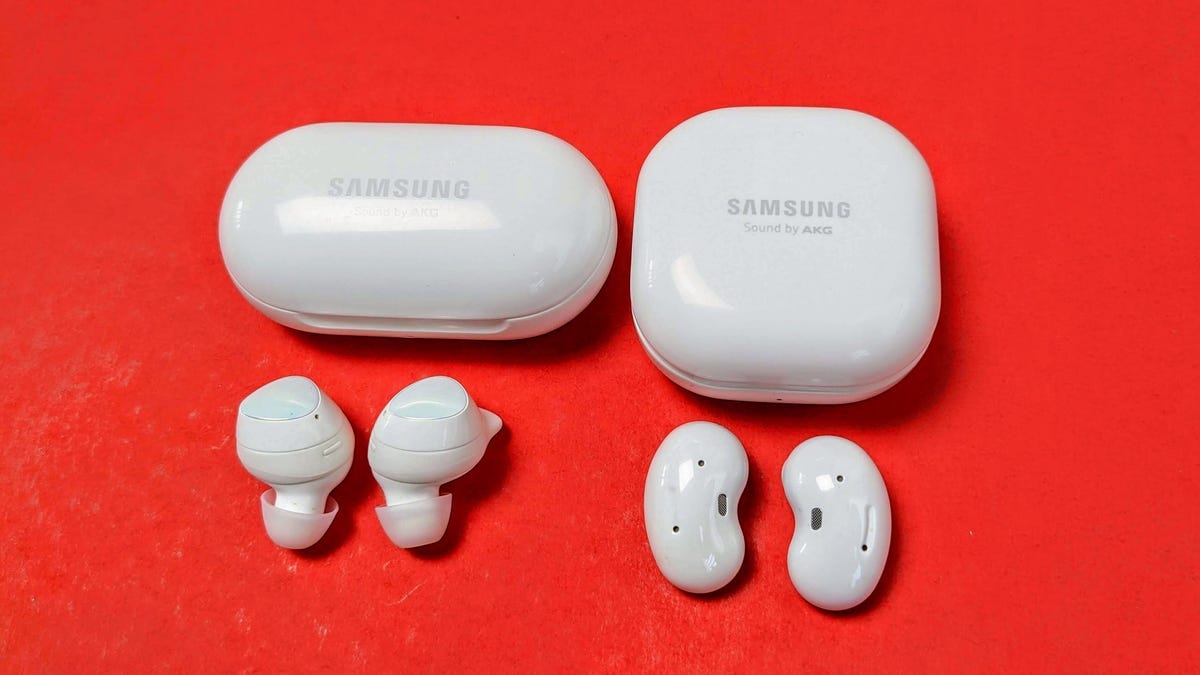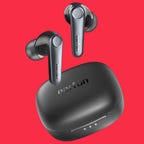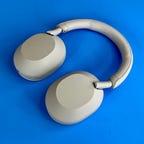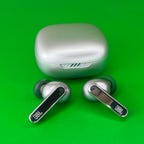
Best Samsung wireless earbuds
Samsung Galaxy Buds 2 Pro
View details

Top budget noise-canceling wireless earbuds
Earfun Air Pro 3
View details

Best noise-canceling headphones from Sony
Sony WH-1000XM5
View details

Best budget Galaxy earbuds
Samsung Galaxy Buds 2
View details

Best AirPods Pro alternative for less
JBL Live Pro 2
View details
Best Sennheiser noise-canceling headphones
Sennheiser Momentum 4 Wireless
View details
Best midrange noise-canceling headphones
Sony CH-720N
View details
New Sennheiser flagship earbuds
Sennheiser Momentum True Wireless 3
View details
Best noise canceling with top-notch sound
Bose QuietComfort Earbuds 2
View details
Best open earbuds for Samsung users
Samsung Galaxy Buds Live
View details
As a Samsung user, you won’t get the full benefits of the AirPods Pro 2, the AirPods Max and the Beats Fit Pro — which are some of Apple’s most popular headphones and earbuds. Of course, they’ll technically connect to and work with your Samsung devices but you won’t get the best overall experience. Apple’s listening accessories have a proprietary chip that works seamlessly with Apple devices. When it comes to Samsung devices, there are limitations. Folks with Samsung devices can use Apple’s headphones and earbuds for audio listening and making calls, but some features — such as spatial audio and always-on Siri — are Apple-exclusive. If you’re a Samsung devotee, you’ll want a set of earbuds or headphones that are either platform-agnostic or geared toward Galaxy devices (Samsung, like Apple, also plays the exclusive-features game).
You may also want to get earbuds or headphones that feature support for the aptX or LDAC audio codecs, which may offer better audio quality when streaming via Bluetooth. Samsung and other Android phones support aptX and LDAC, but you have to enable support for those codecs by going into developer mode in the settings and activating the codec you want. It can be a little tricky.
What are the best earbuds and headphones for Samsung smartphones right now?
What are the best earbuds for Samsung devices? If you’re looking for earbuds geared to your Galaxy smartphone or tablet, the answer is easy: The Galaxy Buds 2 Pros are arguably the best earbuds you can get for your Galaxy device. They not only sound very good but offer good noise canceling and work well for making calls. They’re also equipped with some special extra features for users of Galaxy devices, including spatial audio and hands-free Bixby.
As for full-size headphones that work well with Samsung mobile devices, we like the Sony WH-1000XM5, a previous CNET Editors’ Choice winner. There’s a slew of other headphones geared toward Samsung users, several of which I’ve included on this list.
The Galaxy Buds 2 Pro offer improved noise canceling along with very good sound and voice-calling performance, plus support for high-resolution wireless audio streaming if you’re a Galaxy device owner with the right setup. That said, their biggest upgrade may be their new design and smaller size, which make them a better fit for more ears. They’re also fully waterproof.
Earfun has put out a series of wireless earbuds over the last couple of years with one important similarity: They’re all a very good value, made more so by frequent discounts. The company’s new-for-2023 Earfun Air Pro 3 earbuds feature the latest Qualcomm QCC3071 system-on-a-chip with aptX Adaptive for Android and other devices that support the new LE Audio standard and LC3 audio codec, which is superior to the SBC codec. They also support AAC for Apple devices.
Lightweight and comfortable to wear — I got a good seal with the largest ear tip size — these aren’t a huge upgrade over the Earfun Air S, but they are better. They have slightly larger wool-composite drivers (11mm versus 10mm), slightly improved noise canceling and better battery life (up to seven hours with noise canceling on, according to Earfun).
In short, the Earfun Air 3 delivers strong performance for its modest price, with robust bass, good clarity and a relatively wide soundstage. They also pack in a lot of features, including a wireless charging case and “multidevice” connectivity. (I could pair them to two devices simultaneously but had to pause the music on one device and hit play on the other for the audio to switch.) They’re IPX5 splash-proof and also work well (although not exceptionally well) as a headset for making calls.
When you have a product that a lot of people love, change is risky. Such is the case for Sony’s WH-1000XM5, the fifth generation of the 1000X series headphones, which were first released in 2016 as the MDR-1000X Wireless and have become increasingly popular as they’ve improved with each generation. Over the years, Sony has made some tweaks to the design, but nothing as dramatic as what it’s done with the WH-1000XM5. Other than the higher $400 price tag, most of those changes are good, and Sony’s made some dramatic improvements with voice-calling performance as well as even better noise canceling and more refined sound.
If you can’t afford the Galaxy Buds 2 Pro, the standard Galaxy Buds 2 are a good option. Released in 2021, they don’t sound as good as the newer Galaxy Buds 2 Pro or have quite as effective noise canceling. They do offer decent sound and noise canceling along with very good voice-calling performance, and they often are discounted to around $100.
The Buds 2, like the earlier Buds Plus, is only IPX2 sweat-resistant. That means they should be fine for lighter workouts, but it’s probably best to avoid wearing them in a rainstorm.
Over the years, JBL has put out some decent true-wireless earbuds, but nothing that really got me too excited. That’s finally changed with the arrival of the Samsung-owned brand’s new
The Live Pro 2 and Live Free 2 are equipped with the same 11mm drivers, six microphones, oval tubes and oval silicon tips. Aside from the design, the biggest difference between the two is battery life: The stemless Live Free 2 is rated for up to seven hours, while the Live Pro 2 is rated for 10 hours. The Live Pro 2 is available in four color options.
Sennheiser’s previous-generation Momentum Wireless headphones have always had a pretty distinct look that was part retro, part modern, and stood out for the exposed metal on the headband. For better or worse, that’s all gone now, and the new Momentum 4 Wireless, Sennheiser’s flagship noise-canceling headphones, look a bit more subdued and also a bit more like some of their competitors.
The Momentum 4 Wireless outperforms the Momentum 3 Wireless in every regard. The biggest gains are with noise canceling and voice-calling performance as well as battery life, which is outstanding — up to 60 hours at moderate volume levels. There’s also a transparency mode that allows ambient sound, and users can create a custom sound profile in the Smart Control app for iOS and Android using the built-in EQ, sound modes and a new Sound Personalization feature that “assesses the user’s listening preferences and adjusts the listening experience according to their taste.”
Sennheiser says the Momentum 4 Wireless, equipped with 42mm drivers, offers “best-in-class” sound, which is debatable. I’d say the sound quality is right there with other models in this price range. They sound excellent, with the requisite well-defined, punchy bass, wide soundstage (they sound pretty open) and smooth treble that brings out some of the finer details in well-recorded tracks. They’re a pleasure to listen to.
Sony’s improved entry-level noise-canceling headphones, the CH-720Ns, have a bit of a plastic-y, budget vibe, but they’re lightweight and comfortable. Part of me was expecting them to sound pretty mediocre, but I was pleasantly surprised. No, they don’t sound as good as the WH-1000XM5s. They sound more premium than they look and feel, and their overall performance is a nice step up from their predecessor, the CH-710Ns. Are they worth $150? Maybe — or maybe not. The good news is that, like the CH-710N and WH-XB910 before them, these should see some nice discounts in the not-so-distant future.
The QuietComfort 45 has virtually the same design as its predecessor, the QuietComfort QC35 II, which many people consider one of the most comfortable over-ear headphones — if not the most comfortable. It has the same drivers, and the buttons are in the same place.
There are small but notable changes. First, we’re pleased that these have a USB-C charging port instead of Micro-USB. Secondly, the microphone configuration is different. Not only have the mics been shifted, but there’s now an additional external microphone for voice pick-up, which means the QC45 has a total of six mics, four of which are beamforming and used for voice. By contrast, the QC35 II has four, two of which are used for voice. (The Bose Noise Canceling Headphones 700 also have six microphones total.)
These headphones are excellent for making calls. They’re similar to the Bose Headphones 700 in that regard. They also include top-notch noise canceling and multipoint Bluetooth pairing, so you can connect them with a PC and your phone simultaneously. Read our full review of the QuietComfort 45.
Featuring excellent sound, improved noise canceling and voice-calling, and a smaller, more refined design, the Sennheiser Momentum True Wireless 3 was among the best new true-wireless earbuds of 2022. They’re also one of the best true-wireless earbuds overall, giving the Sony WF-1000XM4 a run for the money. They include stabilizing fins so the earbuds stay in your ears more securely.
Bose’s second-generation QuietComfort Earbuds 2 are not only about 30% smaller than their predecessors, but their case is about 40% smaller and truly pocketable. They feature best-in-class noise canceling and improved sound, thanks to Bose’s new CustomTune sound calibration system that customizes the sound for your ears. Voice-calling performance is also significantly better than that of the original QuietComfort Earbuds.
The other big change is to the ear tips. Bose has ditched its one-piece StayEar wing tips for a two-piece Fit Kit system that features separate ear tips and “stability bands” in three size options. You’ll have more flexibility to get a secure fit and tight seal.
Say what you will about the Samsung Galaxy Buds Live’s bean-shaped design, but it is innovative. Like the standard AirPods 3, they have an open design — you don’t jam an ear tip into your ear — and they’re quite comfortable, fitting my ears more securely than the AirPods. That said, they won’t fit everybody’s ears equally well. These wireless buds are discreet and sit flush with your ear without a little white pipe extending out from them.
They deliver good sound and work well as a headset for making calls, with good background noise reduction so callers can hear you clearly even when you’re in noisier environments. While they feature active noise canceling, it’s mild compared with the noise canceling in earbuds that have a noise-isolating design. In other words, buy them for their design and sound, not their noise-canceling features.
Watch this: Samsung Galaxy Buds 2 Pro Review: Best Galaxy Buds Yet